The best varieties of carrots for open ground: juicy, sweet, fruitful and for winter storage
You just can't decide and choose the type of carrot, can you? Indeed, now there are so many different varieties and hybrids (F1) on sale, the manufacturers of which promise fruitful, juicy and sweet carrots on the packaging, that try to choose among such a variety. In fact, in any case, you will have to go by experience, otherwise you simply won't be able to find something suitable. Another thing is that one should choose from the best.
Below you will be presented with a list of the most popular = best hybrids and varieties of early, medium and late ripening carrots.
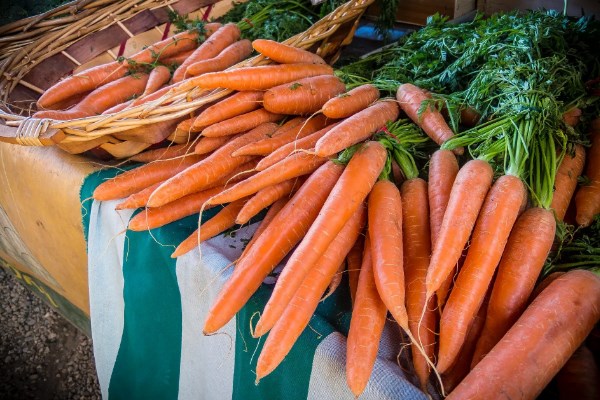
By the way! The site has detailed individual articles on how when and how to plant seeds in the ground in spring and how to care for a high yield.
Content
The best varieties of carrots: top 20 most popular
Note! The list of the best varieties of carrots was prepared based on the degree of popularity of the names of varieties and hybrids, the analysis of reviews of experienced gardeners, as well as the personal opinion of the author.
But before proceeding to an overview of varieties (their names and descriptions), for a better understanding of the differences, we suggest that you get acquainted with the variety types by which all varieties and hybrids of carrots are classified.
Carrot varieties
As a rule, carrots are classified into 10 varieties (7 main and 3 transitional), grouped according to the length and shape (tip) of the root crop.
We will not describe everything (see the diagram-picture at the end of the paragraph), but list only the most common ones (the most popular varieties are in bold, varieties attributed to different groups by different sources are in italics):
- Parisian Carotel: Parisian Carotel, Carotel, Polar Cranberry, Alenka.
- Mini carrots: Khibiny greenhouse, Parmex, Amini, Gregory, Mignon, Minicor.
- Amsterdam (main). Touchon, Amsterdam, Amsterdam, Pharaoh.
- Nantes (main). The most popular variety. The most famous varieties: Laguna F1, Gourmet, Bolero F1, Vitamin 6, Dordogne F1, Nandrine F1, Nantes 4, Samson, Anastasia F1, Nantes Kharkiv, Yaroslavna, Forto, Royal Forto, Yaskrava, Samson, Romosa, Nantes, Rogneda, Napoli F1, Narbonne F1, Heartless, Monanta, Karadek F1, Yoshi F1, Nerak F1, Sirkana F1, Bayon F1, Chukchi style F1, Riga F1, Boar F1. Nantes-14.
- Berlicum / Nantes (transitional): Vitamin 6, Losinoostrovskaya 13, Nandrin F1, Baltimore F1, Baby F1, NIIOH 336.
- Berlikum (Berlikum): Emperor, Baltimore F1, Darina, Berlikum Royal, Morevna, Lakomka, Bangor F1, Bastia F1, Berski F1.
- Flakke (in Russian terminology - "Valeria"). Caramel, Vorobyovskaya, Valeria-5, St. Valeria.
- Flakke / Carotene (transitional): Autumn Queen, Barbara, Golden Autumn.
- Shantane: Abaco F1, Moscow winter A-515, Shantenay-2461, Shantenay Royal (Royal), Kuroda Shantane.
- Shantane / Danvers (transitional): Canada F1.

Early varieties (for fresh consumption and bunch products)
If you want to feast on fresh root crops in June, then you should plant exactly the early varieties of carrots, in which the growing season is from 70 to 90 days (in the mid-early - 80-100).
As a rule, early varieties are intended for fresh consumption (they also say for growing "bundle products"), making freshly squeezed juice, including for baby and diet food. Some of the varieties are also suitable for winter storage, freezing and canning.
Interesting! The most "hit" varieties of early carrots are: Abaco F1 and Touchon.
Abaco F1
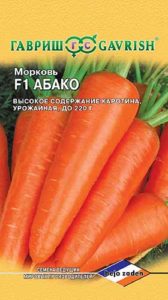
- An early ripe hybrid (from germination to technical ripeness - 80-90 days) of the "Shantane" variety.
- The rosette of leaves is semi-spreading.
- Root crops are dark orange, truncated-conical with a blunt tip, with a thin core.
- Medium sizes: length - 14-16 cm, diameter - 4-5 cm.
- Weight - 105-220 g.
- Productivity - 4.2-5.6 kg / m2.
- They have excellent taste.
- The hybrid is highly productive even on heavy soils.
- Plants are resistant to alternaria and flowering.
- For fresh consumption, winter storage, freezing and canning (for processing).
Caramel
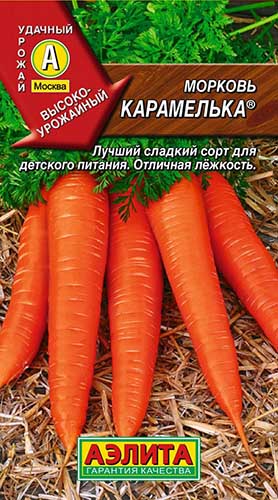
- Mid-early variety (period from germination to technical ripeness - 70-110 days) of the Flakke variety (in Russian terminology - Valeria).
- Root crops are cylindrical, 15-16 cm long, with a smooth and even surface. The color of the roots is orange.
- Weight - 95-160 g.
- The pulp is juicy, tender and very sweet.
- Universal purpose: for fresh consumption, freezing, canning and storage.
- One of the best varieties for baby and diet food. Perfect for making freshly squeezed juice.
- The variety is resistant to cracking and blooming. It is characterized by excellent keeping quality.
Kuroda Shantane

- Medium-early variety (from germination to technical ripeness - 80-100 days) of the "Shantane" variety.
- The rosette of leaves is semi-spreading.
- The root crop is elongated-conical, thick, even, smooth, orange, 18-20 cm long, 3-5 cm in diameter. The core is small. The pulp is juicy, bright orange.
- Weight - 90-160 g.
- Productivity 3.5-4 (up to 5) kg / m2.
- Sweet.
- For fresh consumption (per bunch) and for winter storage.
- Heat-resistant, resistant to blooming and cracking.
Lagoon F1
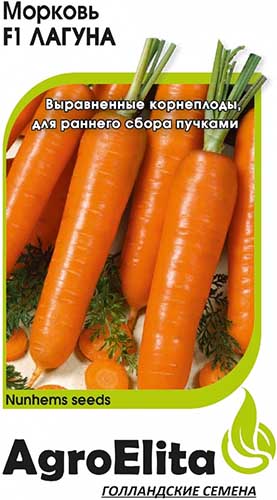
- An early ripe hybrid (from germination to technical ripeness - 65-85 days) of the "Nantes" variety. The beginning of harvesting is possible as early as 60-65 days after the emergence of shoots (per bunch), the main harvest - on 80-85 days.
- The rosette of leaves is semi-spreading, the leaf is medium, finely dissected.
- Root crop of medium length (17-20 cm), fusiform with a blunt tip, the head is even.
- Weight - 80-130 g.
- Productivity - 2.5-3.9 kg / m2.
- Root vegetables are juicy, crispy, excellent taste.
- For fresh use and growing on beam products.
- A characteristic feature is a homogeneous yield of root crops aligned in shape and size.
- Suitable for very early cultivation and winter sowing.
Gourmet
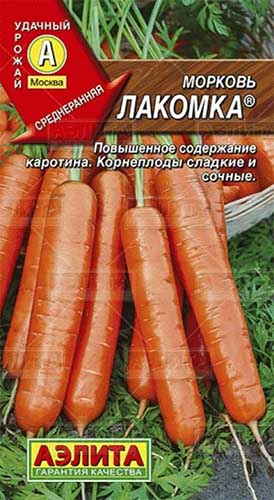
- Mid-early variety (from germination to technical ripeness - 90-100 days) of the "Nantes" variety.
- Root crops are cylindrical, medium, 16-18 cm long, bright orange, with a small core.
- Weight - 90-160 g.
- Productivity - 6-8 kg / m2.
- Excellent taste, with a very tender and juicy pulp and a high content of sugars and carotene.
- For fresh consumption and storage. It is considered one of the best for use in baby food and juice making.
- Resistant to cracking of roots and flowers.
- Perfectly stored without loss of taste.
- Suitable for winter sowing.
Touchon

- A medium-early variety (from germination to technical ripeness - 80-90 days) of the Amsterdam variety.
- The rosette of leaves is semi-spreading.
- Root crops are smooth, cylindrical with a blunt tip, orange, 18-20 cm long.
- They do not have a rigid core.
- Root crops are completely submerged in the soil.
- Weight - 80-150 g.
- Productivity - 5-6 kg / m2.
- It is characterized by excellent taste.
- For fresh consumption (suitable for bundled products) and winter storage.
Slightly less popular early ripe varieties and hybrids of carrots are: Children's sweet, Napoli F1.
Medium ripening varieties (universal)
Mid-ripening varieties include carrot varieties with a growing season of 100 to 120 days.
As a rule, they have universal purpose: suitable for fresh consumption and early picking in bunches, for long-term winter storage and home cooking (juicing, canning, freezing).
Interesting! The most popular varieties of medium carrots are (by fame): Nantes, Shantane, Losinoostrovskaya 13, Vitamin 6 and Baltimore.
Baltimore F1
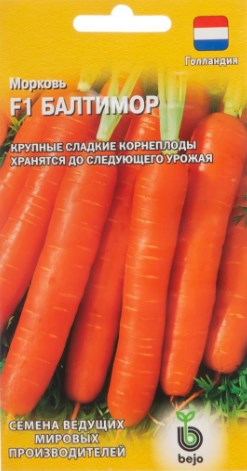
- Mid-season hybrid (from germination to technical ripeness - 103 days). The earliest of the Berlikum cultivar (sometimes referred to as the transitional Berlikum / Nantes).
- The rosette of leaves is erect.
- The root crop is powerful, long (up to 22-25 cm), even, cylindrical in shape with a blunt tip. The core and bark are deep orange.
- Weight - 120-250 g.
- Productivity - 3.4-6.0 (up to 10.0) kg / m2.
- The pulp is tasty, high in sugar and carotene.
- Universal use: used for early picking in bunches, storage (retains taste and useful qualities until the next harvest), suitable for home cooking.
- Resistant to flowers.
- Forms root crops quickly, therefore it can be used for sowing in June.
Bolero F1
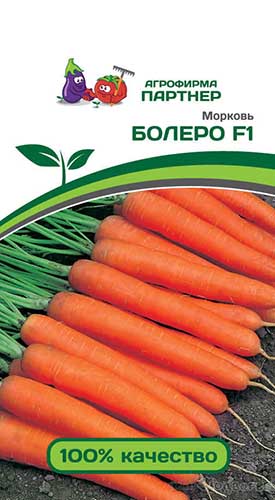
- Mid-season hybrid (from germination to harvest - 110-120 days) of the "Nantes" variety type.
- A medium-sized root crop, cylindrical in shape, with a blunt tip, even, smooth, 18-21 cm long. Fruit color is bright orange.
- Weight - up to 200 g.
- Productivity - 9.0 kg / m2.
- The carrots are juicy and sweet.
- Suitable for long-term winter storage, freezing and growing on beam products.
- A high level of resistance to flowering, alternaria and powdery mildew, has an average resistance to pitya rot of root crops, bacterial leaf spot, cercospora.
- Suitable for growing in difficult climatic conditions.
- Produces friendly shoots even at high temperatures.
Vitamin 6
Interesting! One of the oldest varieties of domestic selection (1969).
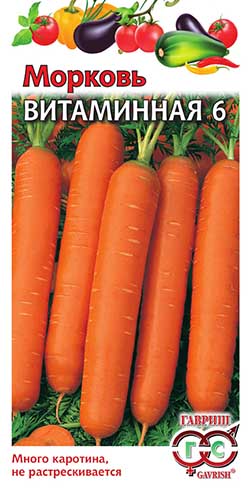
- A mid-season variety (from germination to technical maturity - 78-100 days, according to other sources, up to 120) of the Berlikum-Nantes variety.
- The rosette of leaves is semi-erect.
- The root crop is orange, cylindrical, blunt-pointed, 15-20 cm long, 4-5 cm in diameter.
- The core is small, star-shaped and faceted. Lateral roots are filiform. The eyes are small, the surface is smooth.
- The root crop is almost completely submerged in the soil.
- Weight - 100-160 g.
- Productivity 3.7-7.8 kg / m2.
- The taste of the roots is good.
- For fresh consumption and winter storage.
- The variety is characterized by resistance to flowering, high keeping quality, not prone to cracking.
Dordogne F1

- Mid-season hybrid (from germination to technical ripeness - 115-120 days) of the "Nantes" variety type.
- The root crop is cylindrical, short, with a blunt tip, leveled, smooth, 18-20 cm long.
- Internal structure without a distinct core, homogeneous and uniformly colored, bright orange in color.
- Weight - 125 g.
- Productivity - 5.9 kg / sq.m.
- Recommended for fresh consumption, long-term storage (up to 10 months).
- Root crops do not outgrow or crack.
- The top of the root crop is resistant to greening.
Losinoostrovskaya 13
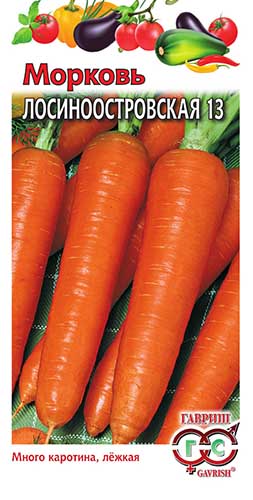
- Mid-season variety (period from germination to technical ripeness - 90-100 days, according to other sources, 110-120) "Berlikum-Nantes" variety type.
- The root crop is cylindrical, slightly tapering towards the base, 16-18 cm long. The surface is smooth, with small eyes.
- Weight - 160-170 g.
- Productivity 6-8 kg / m2.
- The pulp is orange, juicy, very tasty, with a high carotene content.
- For fresh consumption, processing and storage (7-8 months).
- Resistant to flowers.
Moscow winter A 515

- Mid-season variety (the period from full sprouting to technical ripeness is 70-100 days, according to other sources, 110-120 days) of the "Chantenay" variety.
- The socket is half-standing.
- The color of the surface, pulp and core of the root crop is orange. The shape is conical, obtuse. Length - 16-18 cm, diameter 4-5 cm.
- The form cores star-shaped or faceted. The head is concave. Lateral roots are few, filiform, eyes are small.
- The root crop is completely submerged in the soil.
- Weight - 100-175g.
- Marketable yield - 3.1-7.4 kg / m2.
- The taste is good and excellent.
- Recommended for fresh consumption and winter storage.
- Resistant to flowering, has a high keeping quality.
Nandrin F1
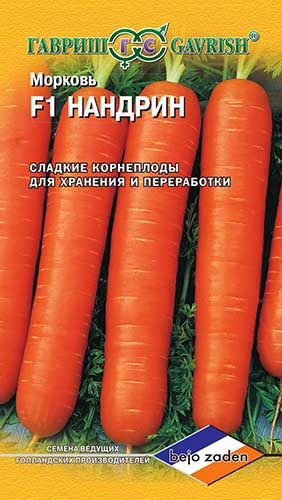
- A mid-season hybrid (from germination to harvesting - 80-104 days) of the "Nantes" variety (sometimes referred to as the transitional "Nantes / Berlikum").
- The socket is powerful, vertical.
- The root crop is bright orange in color, cylindrical, large, 3.5 cm in diameter, 20-25 cm long.
- The root crop is almost completely submerged in the soil.
- Weight - up to 300 g.
- Productivity - 8.0-9.0 kg / m2.
- Sweet.
- Designed for growing in the northern and central regions.
- Suitable for storage and processing, as well as for fresh consumption.
Nantes 4
The oldest variety of domestic selection (1943).
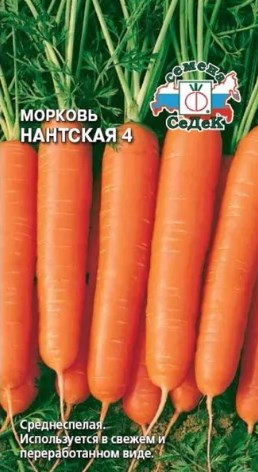
- Mid-ripening variety (from germination to technical ripeness - 78-108 days) of the "Nantes" variety.
- The rosette of leaves is semi-erect.
- The color of the root crop is orange, sometimes by the end of the growing season with green or purple pigmentation of the head, the pulp and core are orange, sometimes light orange.
- The root crop is cylindrical, blunt-pointed, 16 cm long, 4-5 cm in diameter.
- The core is round and angularly rounded. The surface is smooth.
- The root crop is slightly raised above the soil surface.
- Weight - 90-160 g.
- Productivity - 2.5-6.6 kg / m2.
- For fresh consumption, canning, freezing and winter storage.
- It is characterized by resistance to flowering, high keeping quality.
By the way! There are also varieties "Nantes improved" and "Nantes red".
Samson
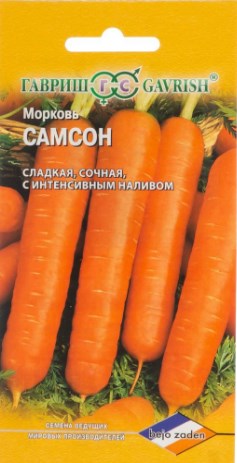
- A mid-season variety (from germination to technical maturity - 110–120 days) of the Nantes variety.
- The root crop is red-orange, cylindrical, blunt-pointed, 16–20 cm long.
- The core is weak.
- The root crop is completely submerged in the soil.
- Weight - 125-150 g.
- Productivity - 5.3-7.6 kg / m2.
- Recommended for fresh consumption, culinary processing and long-term storage.
- It is characterized by excellent keeping quality in winter.
Shantane 2461

- Mid-season variety (from germination to technical ripeness - 105-115 days) of the "Chantenay" variety.
- The rosette of leaves is semi-erect.
- The color of the surface, core and pulp of the root crop is orange. The root crop is conical, blunt-pointed, 15 cm long, 5-6 cm in diameter.
- The root crop is completely submerged in the soil.
- Weight - 80-250 g.
- Productivity - 2.0-4.0 kg / m2.
- The taste is high.
- For fresh consumption and processing.
- It is characterized by resistance to flowering.
Chantenay Royal (Royal)
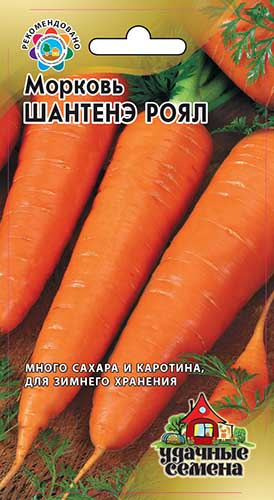
- A mid-ripening variety (from germination to technical ripeness - 90-110 days) of the "Chantenay" variety.
- The rosette of leaves is semi-spreading.
- The root vegetable is bright orange, conical with a slightly pointed tip, aligned, 15-20 cm long.
- Mass - 110-200 g.
- Productivity - 2.0-4.1 kg / m2.
- It is characterized by a high content of carotene and sugar, evenness of root crops.
- Recommended for fresh use and long-term winter storage.
Slightly less popular mid-season carrot varieties and hybrids are: Vita Longa, Autumn King.
Of particular interest is grade "Caramel", which comes in various colors (Caramel yellow, orange, red, raspberry, sugar / white, purple, with filling).
Late varieties (for winter storage)
The late-ripening varieties include carrot varieties with a growing season of 120 to 135 days or more.
As a rule, late varieties are ideal for the longest winter storage. On average, compared to mid-season, they are considered less sweet (but there are exceptions).
Interesting! The most famous varieties of late carrots are (by popularity): Canada F1 and Queen of Autumn.
Anastasia F1
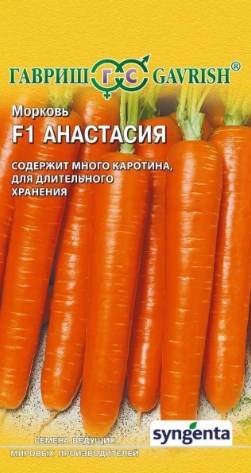
- Medium-late hybrid (from germination to harvesting of root crops - 120-125 days) of the Nantes variety.
- The rosette of leaves is upright, strong (which greatly facilitates harvesting).
- Medium-sized root crop, cylindrical with a blunt tip, up to 22 cm long.
- Weight - 90-160 g.
- Productivity - up to 6.8 kg / m2.
- The heart and bark are bright orange, high in carotene and sugar.
- For baby and diet food, juices, multivitamin salads and soups.
- Root crops are intended for long-term storage (up to 8 months).
- Recommended for early planting dates.
Emperor
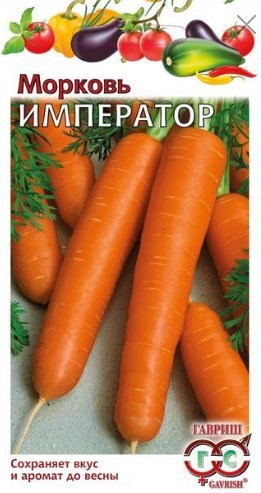
- Late-ripening variety (from germination to harvesting - 120-135 days) of the Berlikum variety.
- The rosette of leaves is semi-spreading.
- The root vegetable is orange-red, long, 25-30 cm, cylindrical with a slightly pointed tip.
- Weight - 90-100 g.
- Productivity - 2-4 kg / m2.
- The pulp is firm, sweet, aromatic, juicy.
- For fresh consumption, juicing and long-term storage (retains marketability and taste until spring).
Canada F1
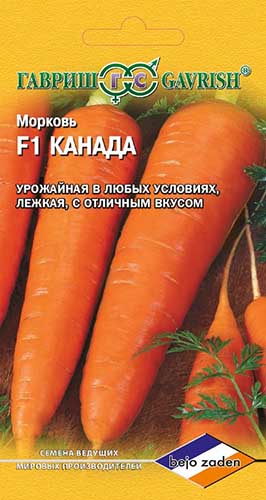
- A late-ripening hybrid (from germination to technical ripeness - 120-135 days) of the "Shantane / Danvers" variety.
- The rosette of leaves is semi-erect.
- The root crop is semi-conical, smooth, with a bright orange color, 20-25 cm long, 4-5 cm in diameter.
- The root crop is almost completely submerged in the soil.
- Weight - 80-140 g.
- Productivity - 5.5-7.6 kg / m2.
- Recommended for fresh consumption and storage.
- It is characterized by resistance to flowering, high keeping quality. Possesses high resistance of leaves to diseases,
- Productive in the most difficult soil and climatic conditions.
Autumn queen

- Late-ripening variety (120-130 days from germination to technical ripeness) of the Flakke / Carotene variety.
- The rosette of leaves is spreading. The leaf is medium, green, finely dissected.
- The root crop is long (22-25 cm), conical in shape, with a slightly pointed tip, the head is convex. The heart and bark are red.
- Weight - 85-230 g.
- Productivity - 4-7 kg / m2.
- The taste is excellent.
- For fresh consumption, processing and long-term storage.
- It is characterized by good disease resistance.
Slightly less popular late-ripening varieties and hybrids of carrots are: Cascade F1, Maestro F1, Nectar F1, Solomon F1, Yaroslavna, Karlena, Red Giant (Rote Riesen).
The best varieties of carrots for winter sowing
The following varieties are suitable not only for spring sowing, but also for winter sowing in the ground (alphabetically):
- Lagoon F1;
- Gourmet;
- Moscow winter A 515;
- Nantes 4;
- Nantes Improved Sugar;
- Nandrin F1;
- Chantenay Royal (Royal);
- Chantenay 2461;
- Losinoostrovskaya 13;
- Vitamin 6;
- Baby sweet.
By the way! About, when and how to sow carrots in autumn before winter, you can read in detail in this material.
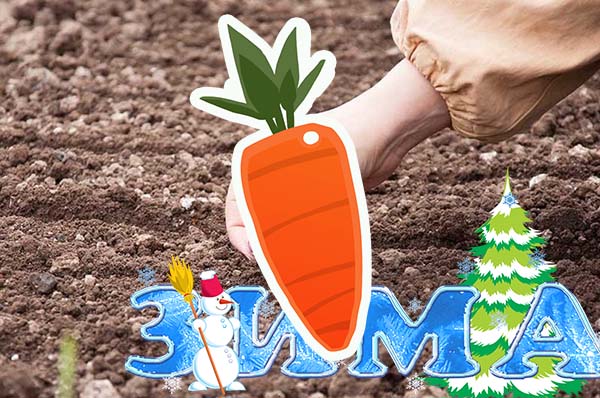
Experiment this year: buy and be sure to plant several different varieties at once, belonging to different varieties. Fortunately, the choice is now huge, and there is no point and interest in constantly planting the same old varieties (the same Vitamin and Nantes 4), if you can try more modern ones - sweet, productive and resistant (to various diseases, cracking, flowering) varieties and hybrids.
Important! Of course, to get a high yield of beautiful and sweet root vegetables, you need to not only choose a good variety, but also plant the seeds in the ground on time and correctly (by carefully preparing the bed), and then take good care of the seedlings right up to harvest.

